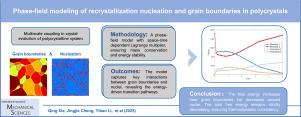Phase-field modeling of recrystallization nucleation and grain boundaries in polycrystals
IF 9.4
1区 工程技术
Q1 ENGINEERING, MECHANICAL
International Journal of Mechanical Sciences
Pub Date : 2025-09-20
DOI:10.1016/j.ijmecsci.2025.110790
引用次数: 0
Abstract
Solid-state recrystallization in polycrystalline materials involves complex interactions between crystal nucleation and grain boundary migration, which significantly affect microstructure evolution and material properties. Modeling this coupled behavior is challenging due to its inherent multiscale nature. This work presents a phase-field model that captures the coupled dynamics of recrystallization nucleation and grain boundary evolution. The model integrates mesoscale boundary migration with microscale nucleation in a thermodynamically consistent framework. Based on Landau theory, a variational formulation is used to derive the governing equations, accounting for multiple energy contributions. To handle nonlinearities and multiscale coupling, a space- and time-dependent Lagrange multiplier is introduced to improve energy stability. Time discretization combines the Crank–Nicolson and Adams–Bashforth methods, while spatial derivatives are solved using Fourier spectral method with complexity. The energy stability of our model is rigorously analyzed. Numerical results demonstrate its accuracy, efficiency, and robustness in reproducing recrystallization pathways and nucleation–boundary interactions. This framework offers a stable and scalable tool for simulating microstructure evolution and understanding multiscale coupling in complex crystalline systems.

多晶中再结晶、成核和晶界的相场模拟
多晶材料的固态再结晶过程涉及晶体成核和晶界迁移之间复杂的相互作用,对材料的微观组织演变和性能产生重要影响。由于其固有的多尺度特性,对这种耦合行为进行建模具有挑战性。这项工作提出了一个相场模型,捕捉再结晶成核和晶界演化的耦合动力学。该模式将中尺度边界迁移和微尺度成核结合在一个热力学一致的框架内。在朗道理论的基础上,利用变分公式推导了考虑多种能量贡献的控制方程。为了处理非线性和多尺度耦合,引入了时空相关的拉格朗日乘子来提高能量稳定性。时间离散结合了Crank-Nicolson和Adams-Bashforth方法,空间导数采用复杂度为0 (NlogN)的傅里叶谱方法求解。对模型的能量稳定性进行了严格的分析。数值结果证明了该方法在再现再结晶路径和核边界相互作用方面的准确性、有效性和鲁棒性。该框架为模拟复杂晶体系统的微观结构演变和理解多尺度耦合提供了一个稳定和可扩展的工具。
本文章由计算机程序翻译,如有差异,请以英文原文为准。
求助全文
约1分钟内获得全文
求助全文
来源期刊

International Journal of Mechanical Sciences
工程技术-工程:机械
CiteScore
12.80
自引率
17.80%
发文量
769
审稿时长
19 days
期刊介绍:
The International Journal of Mechanical Sciences (IJMS) serves as a global platform for the publication and dissemination of original research that contributes to a deeper scientific understanding of the fundamental disciplines within mechanical, civil, and material engineering.
The primary focus of IJMS is to showcase innovative and ground-breaking work that utilizes analytical and computational modeling techniques, such as Finite Element Method (FEM), Boundary Element Method (BEM), and mesh-free methods, among others. These modeling methods are applied to diverse fields including rigid-body mechanics (e.g., dynamics, vibration, stability), structural mechanics, metal forming, advanced materials (e.g., metals, composites, cellular, smart) behavior and applications, impact mechanics, strain localization, and other nonlinear effects (e.g., large deflections, plasticity, fracture).
Additionally, IJMS covers the realms of fluid mechanics (both external and internal flows), tribology, thermodynamics, and materials processing. These subjects collectively form the core of the journal's content.
In summary, IJMS provides a prestigious platform for researchers to present their original contributions, shedding light on analytical and computational modeling methods in various areas of mechanical engineering, as well as exploring the behavior and application of advanced materials, fluid mechanics, thermodynamics, and materials processing.
 求助内容:
求助内容: 应助结果提醒方式:
应助结果提醒方式:


